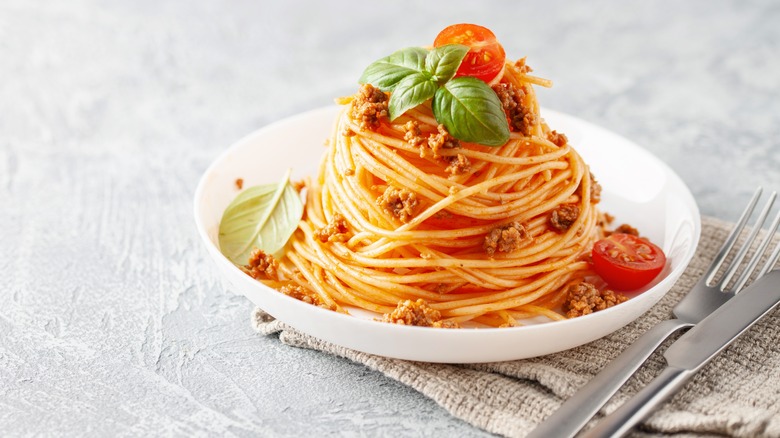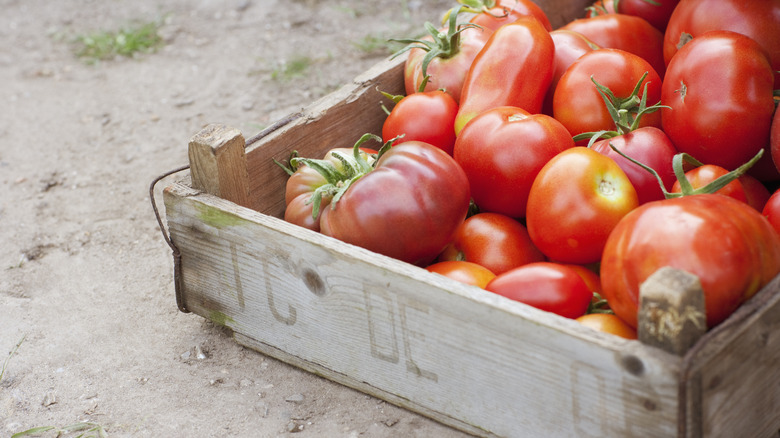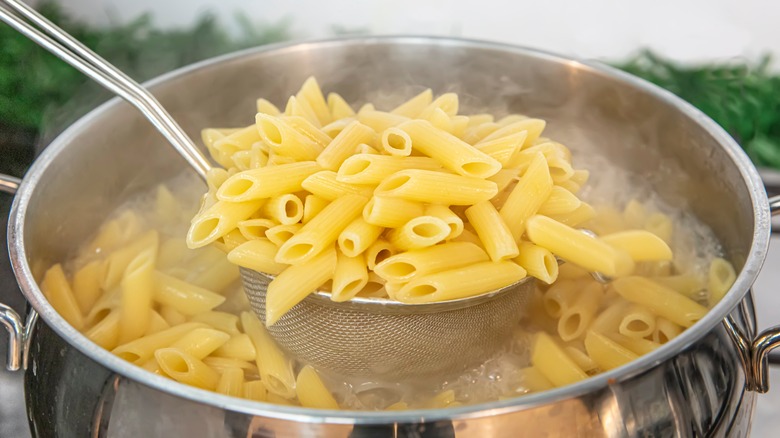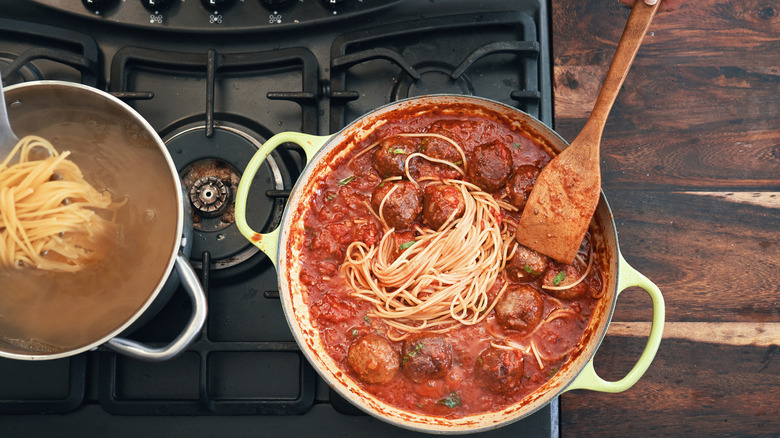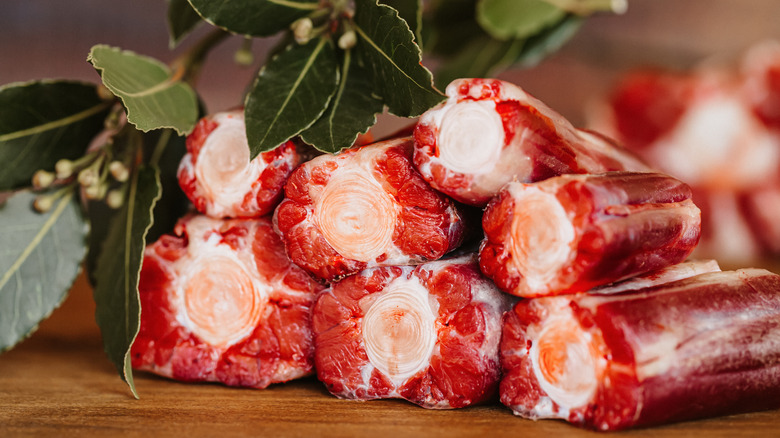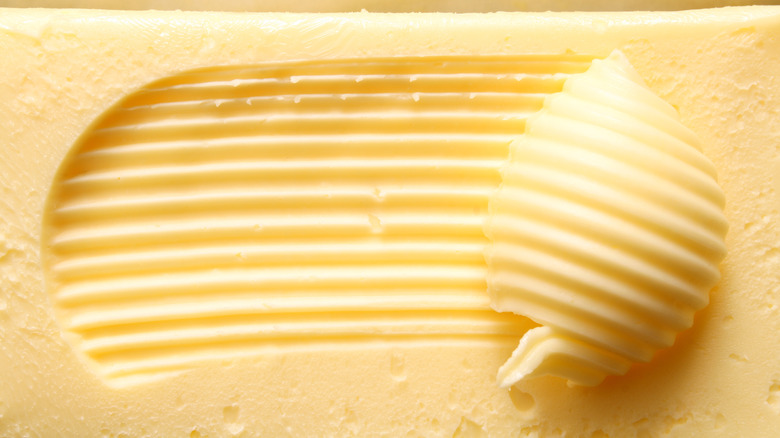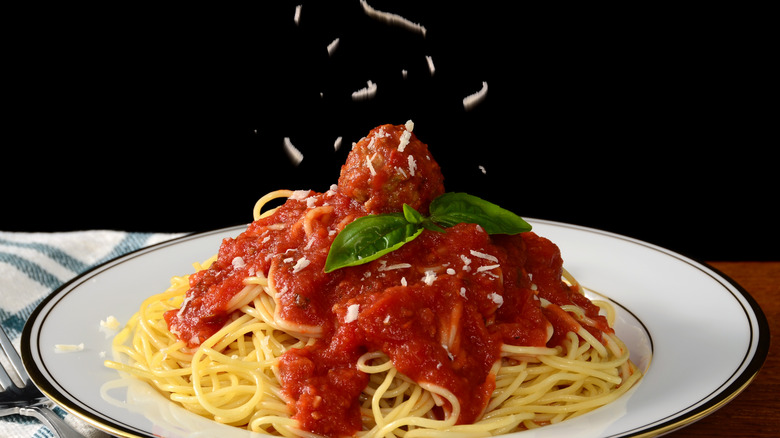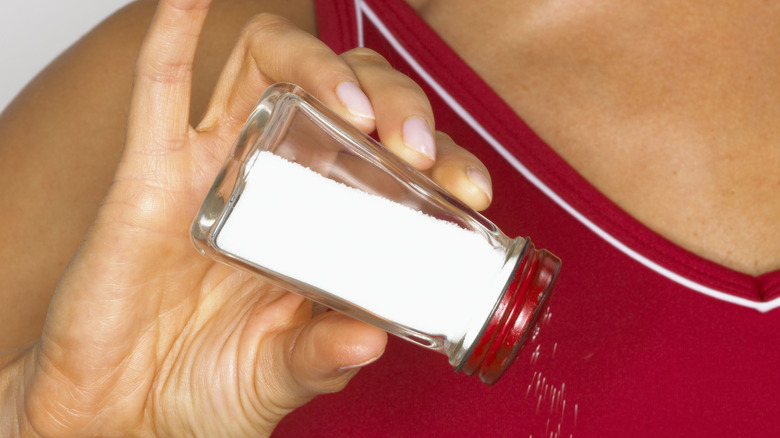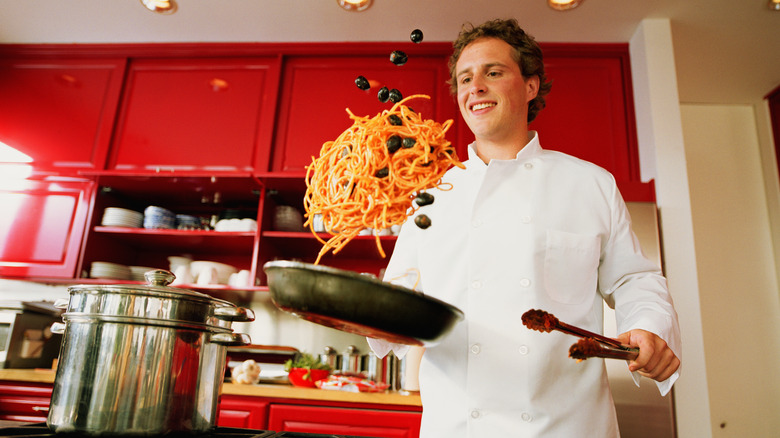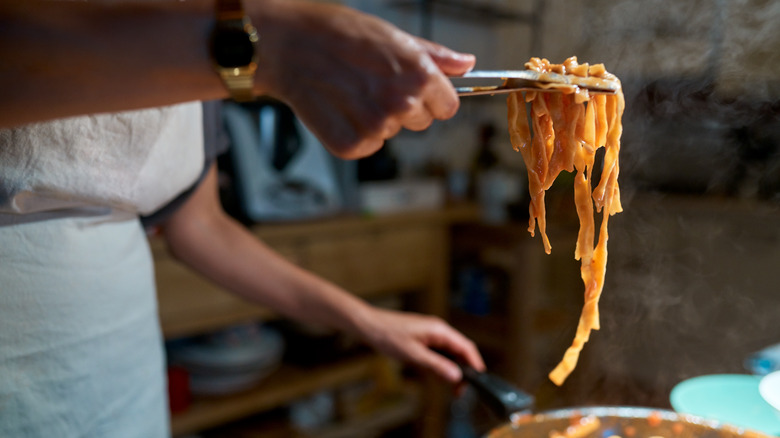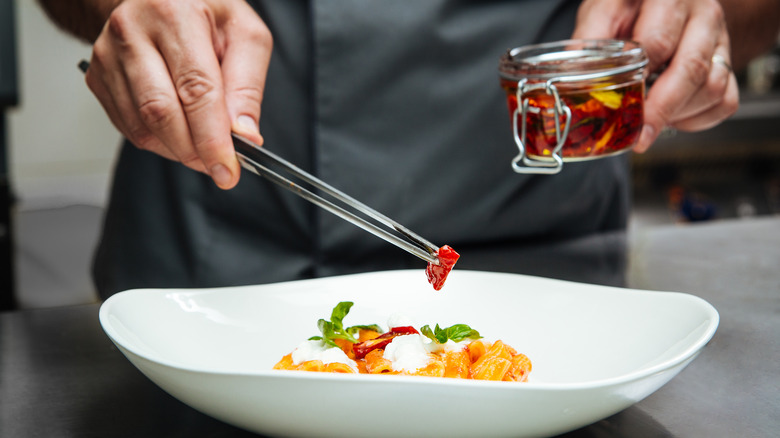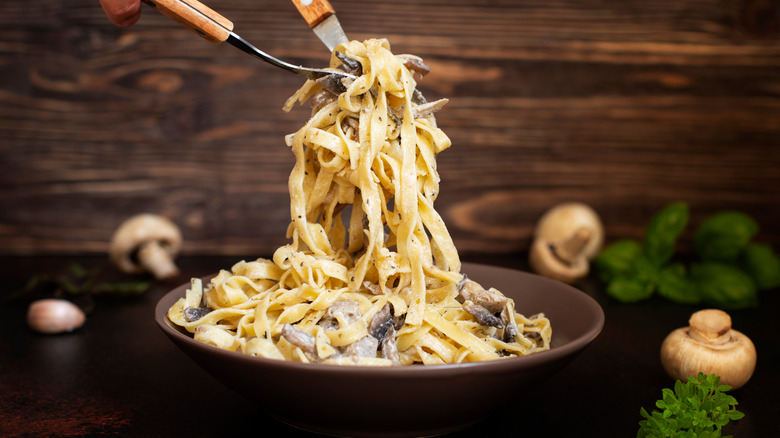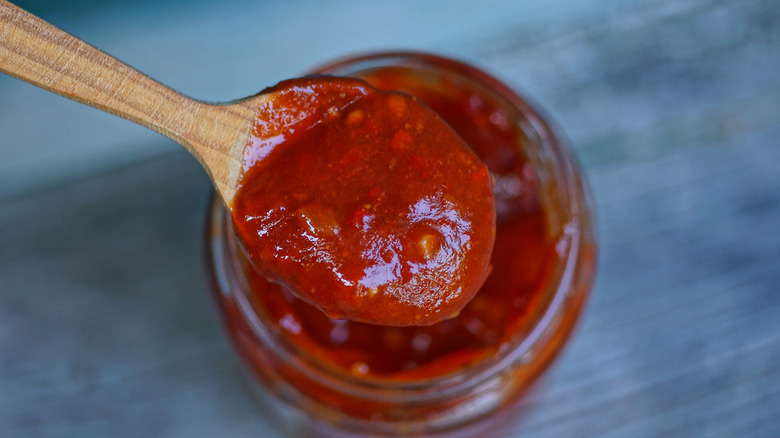Why Pasta Sauce Always Tastes Better At A Restaurant
Whether it's a spaghetti marinara, braised beef ragù, or a cacio e pepe served out of a hollowed-out cheese wheel, there's something about restaurant-made pasta that tastes better. No matter how hard we try, it's tough as a home cook to replicate those flavors, textures, and that wow factor that restaurant pasta has. No, it's not just a question of ambiance — at least not as far as three-time World Pizza Champion Chef Laura Meyer of Berkeley's Pizzeria da Laura claimed. "Technique, equipment, and ingredients all play into creating an amazing dish," she says. "The quality of these three things tends to be higher for restaurant chefs than home cooks."
Don't fret! For the motivated home cook, restaurant-quality pasta is within reach. We're here to help aspiring chefs achieve this with the knowledge gleaned from the trained experts behind some of America's top pasta spots. Formento's Executive Chef Don Walker, Chef Laura Meyer, The Tailor's Son Chef Nick Pallone, and Vice President of Food and Beverage for Tavistock Restaurant Collection Michael Ferraro shared their tips, tricks, and techniques to churn your home kitchen pasta into a top-quality dish.
Restaurants use great ingredients
Sadly, the caliber of ingredients used by chefs in restaurants can be difficult to secure at grocery stores. "Restaurant sauces aren't difficult to recreate at home in the sense that the equipment is generally the same, but access to specific ingredients can be harder," explained Meyer. "Some restaurants work directly with farmers to grow specific herbs and produce that are not native to certain areas giving them access to broader flavor profiles."
Staples like tomatoes, cheese, olive oil, and flour pale in comparison when sourced at grocery stores, as they're often geared towards shelf stability and consistency rather than freshness — resulting in "muted flavors" in home-cooked meals. However, Chef Pallone shared: "By and large the ingredients that are available to chefs are available to the general public. Knowing how to source them — or what to source, for that matter — is the problem." As an example, he cites the ingredient colatura – which is made by fermenting anchovies in chestnut barrels for three years. This ingredient can amplify the flavor of a sauce, but without knowledge or access to it, a home cook would be hard-pressed to replicate it.
Ferraro agreed with Pallone, too. He shared that high-quality ingredients are available in grocery stores but people opt for the "affordable option" rather than "investing" in specialty items.
Restaurants know the power of cooking water
For Ferraro, the key to mastering restaurant-quality pasta at home is relying on a commonly wasted byproduct: the starchy water from boiling pasta. "Pasta water is your friend," he said. "I don't think that home cooks know that." He further explained that the water used to cook pasta seasons not just the pasta but the sauce itself, imparting essential salt and starch for the optimal texture and flavor in the finished dish.
As for how much to use, that all depends on the type of sauce you seek. "With many pan sauces, even if it's just an olive oil and garlic pasta, your sauce, essentially, is your pasta water," he said. In any case, it's likely you'll need more of this water than most home cooks would think. "Whether the sauce derives from the pasta water itself, so something like a cacio e pepe, or it's just to adjust a seafood pasta, a marinara, whatever it is... We're using pasta water."
Restaurants finish pasta in the sauce
While starchy cooking water may finish a sauce, the sauce finishes a pasta dish — at least in professional restaurant kitchens. "When the pasta comes out of the water all of those gluten strains are looking for a protein to grab a hold of, making it the perfect time to mix it with a sauce," explained Chef Walker. "You always want to cook/toss the pasta with the sauce before plating as it will adhere to all of those flavors you worked to achieve!"
Meyer agreed... with a caveat. "It's important to cook the pasta in the sauce for a short period," she said. "Pasta doesn't need to cook for a long period within the sauce but you are looking for the pasta to absorb some of the sauce before it reaches a diner. You want the final dish to taste homogenous and cohesive. If the pasta is overcooked before it meets the pasta it won't absorb the sauce and if it hasn't had time to meld it tastes like two separate elements."
Pallone agreed, stating: "Finishing cooking the pasta in the sauce is essential. The starch from the pasta when added to the sauce in a pan will thicken and help bind the sauce to the pasta."
Restaurants build an aromatic base for their sauces
Pasta water isn't the only base ingredient that restaurants add to their sauces. According to Ferraro, the bases for sauces are hard-won flavor bombs that take effort and planning to perfect. "Building flavor is an important thing, and it takes time," he said. "You can make a marinara sauce in 30 minutes, or you can make it in six hours."
Often, a restaurant will often opt for the latter. Pallone added, "Time is usually an issue when cooking at home, which by nature speeds the process up and in doing so makes for an underdeveloped sauce." But by taking the time to develop the complex aromatic layers chefs seek in professional kitchens, there's no reason a home cook shouldn't be able to glean those same flavors.
While in many cases, aromatic vegetables like onion, garlic, celery, or carrot make the sauce, Ferraro believes long-simmering sauces should start with bones. "Roast your bones," he suggested and noted that for the best flavor, chefs opt for sometimes-pricey (but totally worthwhile) marrow bones: These bones are slow-roasted to develop deep, caramelized flavor. Adding these bones to the sauce and letting them simmer will result in a mixture that may be time-consuming but will have a far more developed flavor.
Walker echoed, "Food is food. It's all about taking the time and care on preparing items to how you see fit."
Restaurants add more fat and cheese
While you might be watching butter, oil, or cheese at home, restaurants don't skimp out on these delicious and flavorful ingredients. "Restaurants are using full-fat everything," Meyer shared. "Fat is a big component to flavor and using high-fat contents and full-fat ingredients is going to punch up the flavor of any dish." Walker agreed, noting that adding butter "really helps bring out that flavor you may be missing at home."
But it's not just a question of adding gobs of fat to a sauce willy-nilly. Ferraro explained that there's a method to the madness. He begins his sauces with extra-virgin olive oil and only adds butter right at the end to unite a finished sauce, cooked pasta, and cooking water. "Bring that up to a full simmer or boil, sauté it a bit, incorporate those flavors, and then add, depending on the portion size, one to two tablespoons of good-quality butter," he said. "At that point, reduce the heat down to very, very low, and you're basically now just mounting your sauce with butter."
Restaurant chefs don't neglect cheese
It's no surprise that pasta and cheese are the perfect pairing. But in many cases, cheese shouldn't just be a topping for pasta, but rather an ingredient in the sauce. According to Ferraro, adding cheese along with the butter allows the cheese to emulsify into the dish and coat each pasta strand. "At this point, your flame is essentially low to off," he cautioned. Adding cheese over high heat can cause the sauce to break and turn greasy or gritty. "You're only mounting and emulsifying this dairy product into your sauce to create a mouthfeel, a texture, a creaminess, a flavor."
Yes, Ferraro notes that it's a small detail, but it enters into a bigger philosophy that chefs adhere to when creating any dish. "Most restaurants that are cooking at a certain level go through the process of building flavors," he said. By taking the time to coax out the best of each addition, the resulting pasta dish will be even more layered and nuanced.
Restaurants use extra salt
In addition to butter and cheese, one ingredient restaurant chefs typically won't scrimp on is salt. One 2017 study found that 80 percent of our average sodium consumption comes from meals prepared by pros. The average sodium content of a single restaurant menu item comes in at more than half of the daily recommended limit.
Walker noted, "Saltiness is in the eye of the beholder," who prefers a slightly heavier hand with salt to make dishes taste even more "exciting." He added, "I personally like my food well-seasoned." Of course, we're not suggesting that you up your seasoning so much as to render your home-cooked meals unhealthy, but the reality is that salt makes the flavors pop. Consider doing as chefs do and investing in a top-quality finishing salt like flaky Maldon's, mineral-rich pink Himalayan, or Pallone's favorite: Trapani. "It's some of the best salt from the Sicilian sea," he said. "It's inexpensive and still great to finish dishes with."
Restaurant chefs know when enough is enough
Despite what some of these tips might imply, bigger isn't always better when it comes to pasta sauces. According to Walker, a truly delicious pasta sauce is often an exercise in simplicity. "Great sauces contain only a few ingredients," he explained. "When you start 'crowding the box' with too much, it can overwhelm the taste buds, and the main flavors get lost in the mix."
Mastering this balance is mostly a question of practice and expertise gleaned over years of experience. Rather than adding extra ingredients and seasonings, Pallone touted the virtues of small adjustments that can make a huge difference. "Sometimes overlooked and not thought about is the little things," he stated. "The hotter the pan, the more vigorously you will have to work, but the heat will aid in the emulsification of the sauce. Agitating the pasta, specifically a longer noodle, with a spoon (I teach my line cooks to use a fast circular motion with a spoon) will aid in that noodle releasing starch and ergo make it easier for the sauce to adhere to the noodle."
While home cooks don't have the benefit of a chef over their shoulder telling them what to do, with enough experimentation, these techniques will come naturally. "Adjust and play around with the recipe," suggested Pallone. "There is no hard and fast way to do anything. It is about knowing the basis and evolving."
Restaurant chefs know when to cut the heat
Less is more when it comes to ingredients, but the same is true of cooking time. "Certain sauces are simmered for long periods but not all sauces are," Meyer cautioned. "The length of cook time is not synonymous with more flavor. Sometimes long cook times negatively affect sauces as fresh and more subtle flavors get cooked out."
Pallone echoed this sentiment, noting that even sauces that are also braised, like a Sunday ragù or a pot of luscious meatballs in tomato sauce, have an apex of perfection. "Slow cooking concentrates flavors and breaks down carbohydrates in turn caramelizing and building flavor," he said. "However, there should be a balanced approach to this method, as simmering too long can lead to an undesirable result." This fact is particularly true of any sauce containing fresh herbs, which will lose their aromatic qualities the longer they cook. He cautioned, "Even worse, the sauce will taste off — as the flavors have over-concentrated or, at worst, scorched."
Restaurants plate better
We eat with our eyes first — a fact of which chefs are well aware. "A sloppy mess on a plate isn't the most appealing," Walker said. "Making sure to 'dress' your dish will always be better received." Meyer takes this a step further, noting that "the visual element of dining is almost just as important as the flavor of the dish. If the dish Is presented in an odd way or it is visually deceiving," she adds, "it can trick the mind into thinking that is going to taste bad."
But this isn't just a question of aesthetics. "Plating can completely change a dish," she asserted. "If the plate is too flat and the pasta is meant to be sitting in a broth, this can completely change the way the dish is tasted by the diner."
If bad plating can ruin a dish, great plating can catapult an otherwise humble pasta to new heights. Ferraro recalled a homemade dish he made with ingredients cousins brought him from Italy, a combination of simple dried pasta, Italian tomato sauce, Calabrian chile, oregano, and fresh basil. "I plated this up just for me; I was home alone," he recalled, noting that he posted a photo of the dish on Instagram. "People were like, 'Omigod, where are you? That looks so great!' I was like, 'I literally just made this at home right now, and I'm about to watch Netflix.'"
Restaurants know which shape to use for which sauce
Italy is home to 350 pasta shapes, and while you certainly could mix and marry marinara and mafaldine or cacio e pepe with capellini, not all sauces are suited to all pasta shapes. Generally speaking, heartier sauces like bolognese or ragù are best when paired with wide noodles like pappardelle or with large tubes like rigatoni, which will capture all of that lovely sauce. Creamy sauces tend to be happiest with noodles that capture all of that lusciousness, such as cavatappi or farfalle, or even longer noodles like spaghetti or linguine, provided they're bronze-extruded, a process that renders a far more textured noodle to which sauces cling.
When it comes to thinner noodles like capellini or angel hair, meanwhile, simple pan sauces are ideal: Think aglio e olio or a fresh pomodoro sauce. With a pairing like this one, neither the sauce nor the pasta overwhelms the finished dish.
Things can get even more specific when it comes to certain regional specialties. In Liguria, local pesto is happiest when served with local trofie, a twisted fresh pasta boasting irregular spirals that hold pockets of the flavorful basil-based sauce Genoa is so known for. In Rome, meanwhile, the local delicacy of amatriciana sauce, made with chunks of cured pork cheek known as guanciale and a chunky tomato sauce, is perfect when paired with bucatini, a hollow spaghetti-like strand that's chewier and denser than the more familiar noodle.
Restaurant chefs don't use preservatives
We certainly can't speak for all restaurant chefs, but in any kitchen making its own sauce from scratch, you won't find any of the preservatives or stabilizers used in many shelf-stable pasta sauces. Less-than-palatable additives to store-bought sauces may include cheaper oils like canola oil, which boasts way less flavor than the extra-virgin olive oil Ferraro prefers, or added sugar, which serves to balance the acidity of less-than-stellar tomatoes.
But in addition to underwhelming flavor, store-bought sauces can also contain gums like xanthan gum or preservatives like sodium phosphate and potassium metabisulfite. Xanthan gum, which is a common additive to gluten-free products to add texture and structure, isn't harmful per se, but it has been shown to lead to digestive problems for some. Sodium phosphate, while generally recognized as safe by the FDA, has nevertheless been linked to elevated mortality rates, particularly for those who already have kidney or cardiovascular diseases or issues. And one recent study in lab rats showed that even in small amounts, potassium metabisulfite can be toxic, producing excessive free radicals, which can lead to illness, premature aging, or even cancer.
Is consuming a store-bought pasta sauce a death sentence? No, of course not. But if you want the freshest flavors and the healthiest ingredients, it's best to do as chefs do and make your sauce from scratch.
